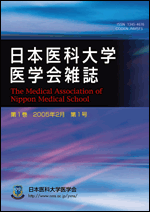Volume 11, Issue 1
Displaying 1-13 of 13 articles from this issue
- |<
- <
- 1
- >
- >|
-
2015Volume 11Issue 1 Pages 3
Published: February 15, 2015
Released on J-STAGE: March 06, 2015
Download PDF (269K)
Photogravure
-
2015Volume 11Issue 1 Pages 4-5
Published: February 15, 2015
Released on J-STAGE: March 06, 2015
Download PDF (377K)
Review
-
2015Volume 11Issue 1 Pages 6-11
Published: February 15, 2015
Released on J-STAGE: March 06, 2015
Download PDF (333K)
Article
-
2015Volume 11Issue 1 Pages 12-15
Published: February 15, 2015
Released on J-STAGE: March 06, 2015
Download PDF (277K)
-
2015Volume 11Issue 1 Pages 16-19
Published: February 15, 2015
Released on J-STAGE: March 06, 2015
Download PDF (380K)
Case Reports
-
2015Volume 11Issue 1 Pages 20-24
Published: February 15, 2015
Released on J-STAGE: March 06, 2015
Download PDF (982K) -
2015Volume 11Issue 1 Pages 25-28
Published: February 15, 2015
Released on J-STAGE: March 06, 2015
Download PDF (629K)
Humanities, Natural Sciences, and Medicine
-
2015Volume 11Issue 1 Pages 29-36
Published: February 15, 2015
Released on J-STAGE: March 06, 2015
Download PDF (312K)
Nurse' s Series
-
2015Volume 11Issue 1 Pages 37-40
Published: February 15, 2015
Released on J-STAGE: March 06, 2015
Download PDF (229K)
-
2015Volume 11Issue 1 Pages 41-42
Published: February 15, 2015
Released on J-STAGE: March 06, 2015
Download PDF (227K)
-
2015Volume 11Issue 1 Pages 43-46
Published: February 15, 2015
Released on J-STAGE: March 06, 2015
Download PDF (288K)
-
2015Volume 11Issue 1 Pages 47-54
Published: February 15, 2015
Released on J-STAGE: March 06, 2015
Download PDF (465K)
-
2015Volume 11Issue 1 Pages 55-57
Published: February 15, 2015
Released on J-STAGE: March 06, 2015
Download PDF (211K)
- |<
- <
- 1
- >
- >|
